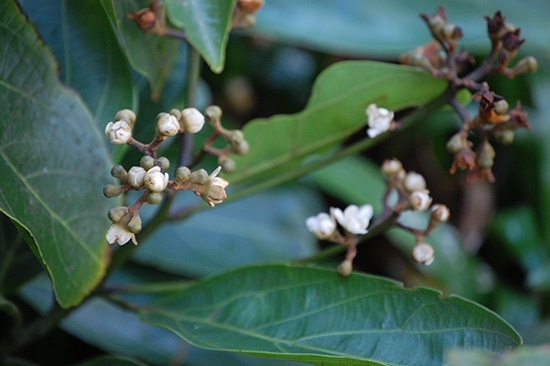

In vitro trials point to antiparasitic and anti-inflammatory actions of a substance isolated from Nectandra leucantha, a tree species common to the Atlantic rainforest biome (photo: release)
In vitro trials point to antiparasitic and anti-inflammatory actions of a substance isolated from Nectandra leucantha, a tree species common to the Atlantic rainforest biome.
In vitro trials point to antiparasitic and anti-inflammatory actions of a substance isolated from Nectandra leucantha, a tree species common to the Atlantic rainforest biome.

In vitro trials point to antiparasitic and anti-inflammatory actions of a substance isolated from Nectandra leucantha, a tree species common to the Atlantic rainforest biome (photo: release)
By Karina Toledo
Agência FAPESP – A natural compound isolated from trees of the species Nectandra leucantha, a close cousin of the Jamaican sweetwood that is known in Brazil as canela-seca or canela-branca, displayed antiparasitic and anti-inflammatory activity in laboratory experiments and could be used to treat visceral leishmaniasis and Chagas disease.
The research is being conducted with FAPESP’s support as a collaboration between the Adolfo Lutz Institute (IAL), the Federal University of São Paulo (UNIFESP) in Brazil, and Ohio State University in the United States. Some of the results were published in April in the Journal of Natural Products.
“If in vivo preclinical assays show the molecule to be effective and safe, it may serve as a prototype for the development of a new drug,” said André Gustavo Tempone, a researcher affiliated with IAL.
The compound, which is a lignoid (dimeric phenylpropanoid), was isolated during Simone S. Grecco’s doctoral research, which was performed concurrently at the Federal University of the ABC’s Center for Natural & Human Sciences (CCNH-UFABC) and UNIFESP’s Environmental, Chemical & Pharmaceutical Science Institute under the supervision of Joao Henrique Ghilardi Lago, a professor at UNIFESP.
The study was part of a project entitled “Sustainable use of biodiversity in Atlantic Forest remnants in São Paulo: evaluation, isolation and molecular characterization of bioactive secondary metabolites in plant species”, supported by FAPESP and coordinated by Lago.
“The compound proved interesting immediately, as we were able to isolate a large amount in the laboratory,” Tempone said. “Only a few milligrams of any active substance are typically obtained in research on natural products, but the UNIFESP group managed to obtain grams, which greatly facilitates preclinical testing.”
The first experiments, led by Tempone at IAL, showed that the compound killed parasites of the species Leishmania infantum, which causes visceral leishmaniasis, and of the species Trypanosoma cruzi, which causes Chagas, without causing significant toxicity in mammalian cells.
Thanks to a partnership with Abhay Satoskar, a professor of pathology at Ohio State University, postdoctoral student Thaís Alves da Costa-Silva was able to go to the US to investigate the compound’s effect on the cells of the immune system.
Costa-Silva infected mouse macrophages with parasites of the species Leishmania donovani, which also causes visceral leishmaniasis and is common in Asian countries. The next step was to treat the cultures with the lignoid and to evaluate the production of inflammatory molecules typically released by defense cells to combat pathogens.
“Besides the antiparasitic activity that we’d already demonstrated here in Brazil against L. infantum and T. cruzi,” Tempone said, “she also observed that the macrophages produced smaller amounts of two different inflammatory cytokines, interleukin-6 (IL6) and interleukin-10 (IL10). These molecules typically exacerbate the disease by making the immune system attack the sick organism’s tissues in its attempt to combat the parasite. So, the compound is effective in two ways.”
In vivo testing
The next step in the drug development process is to evaluate the candidate molecule’s safety and effectiveness in animal testing. To increase the chance of success, however, Tempone plans to perform pharmacokinetic and pharmacodynamic tests before embarking on in vivo trials.
The main aim of these tests is to find out how the compound is metabolized in the organism, how long it takes to be broken down, and what substances result from its metabolization.
“These results will help us to plan the preclinical trials by determining the right dose and how many times per day the compound should be administered, so that we can minimize the use of animals,” he said.
The group is currently performing in vitro tests to explore the mechanism by which the lignoid kills parasites. In the future, if the compound also proves effective in vivo, they plan to develop more potent synthetic analogs.
“Another positive aspect of the molecule isolated from Nectandra leucantha is its relatively simple chemical structure, which would facilitate the creation of a synthetic version. This is desirable for the pharmaceutical industry because it makes the scaling-up process economically feasible,” Tempone said.
Both leishmaniasis and Chagas are considered neglected diseases, meaning that there is little investment in research to improve their treatment or prevention despite the fact that they are endemic among low-income populations, especially in tropical regions.
Bangladesh, Brazil, India, Nepal, Sudan and South Sudan account for more than 90% of all visceral leishmaniasis cases. The disease is almost always fatal if left untreated. The current approach to treatment uses highly toxic drugs such as amphotericin B and antimony.
The World Health Organization (WHO) estimates that approximately 12 million people are currently infected by T. cruzi in the Americas, 2–3 million of them in Brazil. Treatment with benznidazole is also considered toxic and relatively ineffective.
The article “Immunomodulatory and Antileishmanial Activity of Phenylpropanoid Dimers Isolated from Nectandra leucantha” (doi: 10.1021/np500809a) can be read at pubs.acs.org/doi/abs/10.1021/np500809a.
Republish
The Agency FAPESP licenses news via Creative Commons (CC-BY-NC-ND) so that they can be republished free of charge and in a simple way by other digital or printed vehicles. Agência FAPESP must be credited as the source of the content being republished and the name of the reporter (if any) must be attributed. Using the HMTL button below allows compliance with these rules, detailed in Digital Republishing Policy FAPESP.





